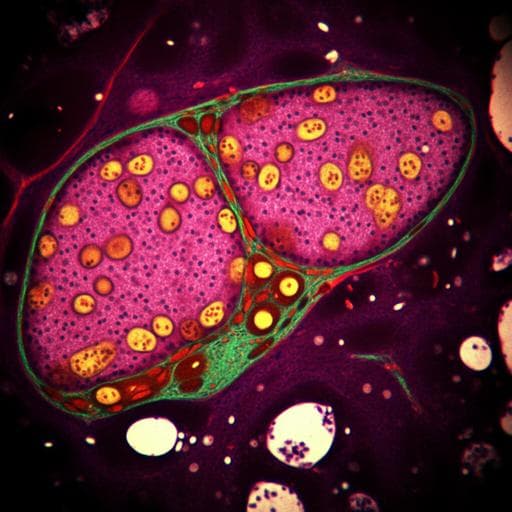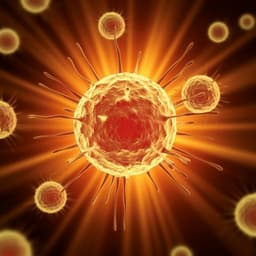
Medicine and Health
Effects of maternal diet-induced obesity on metabolic disorders and age-associated miRNA expression in the liver of male mouse offspring
L. V. Mennitti, A. A. M. Carpenter, et al.
This study by Laís Vales Mennitti and colleagues uncovers alarming insights into how maternal obesity affects the liver health of older male offspring. The research reveals notable increases in body weight, fat mass, and harmful liver conditions linked to elevated levels of specific miRNA, hinting at potential implications for aging processes in offspring due to maternal dietary habits.
~3 min • Beginner • English
Introduction
The study addresses how maternal diet-induced obesity affects liver phenotype and age-associated miRNA expression in male offspring, particularly focusing on potential accelerated aging processes. Maternal obesity during pregnancy can program long-term changes in offspring via epigenetic mechanisms, including miRNAs, increasing susceptibility to obesity, type 2 diabetes, cardiovascular disease, and nonalcoholic fatty liver disease (NAFLD). Prior research has shown maternal obesity/high-fat feeding can program miRNA expression, but typically examined single time points in young adulthood. Aging begins before birth and is linked to programmed phenotypes, with evidence that maternal obesity predisposes offspring to premature aging and NAFLD progression in a sex-specific manner. This study investigates the liver phenotype at 12 months of age in male mice born to obese dams and examines whether age-related changes in hepatic miR-582 expression accompany and potentially mediate these programmed effects.
Literature Review
- Maternal obesity is increasingly prevalent and is associated with long-term programmed effects in offspring, including increased risk of obesity, type 2 diabetes, CVD, and NAFLD, mediated by epigenetic mechanisms (DNA methylation, histone modification, miRNAs).
- Disturbances in miRNA expression are implicated in metabolic diseases; hepatic miR-582 has been reported to increase with high-fructose diet and in cirrhotic livers. Maternal obesity/high-fat diets can program miRNA expression across tissues, but most studies focus on young adults.
- Aging is linked to developmental programming; individuals exposed to suboptimal maternal environments are more susceptible to age-associated diseases. Prior work indicates maternal obesity predisposes offspring to premature aging and NAFLD progression, with limited studies assessing aged offspring across organ systems.
- These gaps support evaluating both metabolic phenotype and age-related miRNA changes (miR-582-3p/-5p) in offspring across young adult and older adult ages.
Methodology
Design: Mouse model of maternal diet-induced obesity (C57BL/6J). Female mice fed from weaning either control chow (RM1) or an obesogenic diet (high-fat with sweetened condensed milk and mineral mix). Breeders were mated when control dams had <5 g body fat and obese dams >10 g (TD-NMR assessed). Dams maintained diets through pregnancy and lactation. Litters standardized to six pups on postnatal day 2. Male offspring weaned at day 21 onto control diet.
Groups: CC (offspring of control dams) and OC (offspring of obese dams). Only one male per litter used for each outcome (n denotes litters and offspring).
Ages and sample sizes: 8 weeks (n=8 per group, tissues collected; this study analyzed liver and body composition) and 12 months (n=9 per group for most outcomes). Body weight recorded from 3 weeks; body composition by TD-NMR from 4 weeks, weekly to 12 weeks, monthly to 52 weeks.
Measurements at 12 months:
- Serum metabolites: insulin, leptin (ELISA); total cholesterol and triglycerides (Dimension RxL analyzer); HDL (homogeneous detergent assay); LDL calculated by Friedewald equation; free fatty acids (Roche kit). HOMA-IR calculated as [fasting insulin × fasting glucose]/22.5.
- Glucose tolerance test: after 16 h fast, intraperitoneal glucose (1 g/kg), blood glucose measured at 0, 15, 30, 60, 120, 180 min; AUC by trapezoids.
- Liver lipid content: modified Folch extraction; expressed also as % liver weight.
- Histology: H&E-stained sections (7 µm) for steatosis grading (0–3) by blinded pathologist; Picrosirius Red (5 µm) for collagen quantification (ImageJ L*a*b analysis) and fibrosis staging (Kleiner classification) by blinded pathologist.
- Apoptosis: TUNEL assay on paraffin sections (Takara kit), DAB-positive nuclei quantified with QuPath; % positive cells relative to total nuclei.
- RNA analyses: Total RNA (miRNeasy); quality by 260/280 and 260/230 ratios. miRNA: TaqMan RT and qPCR for miR-582-3p (Assay ID: 472692_mat) and miR-582-5p (Assay ID: 471065_mat), normalized to miR-25-3p (stable across groups). mRNA: cDNA (High-Capacity kit), qPCR (SYBR Green) for genes related to fibrosis (Col1a1, Col3a1, Col4a1, Tgfb1), apoptosis (Bax, Bcl-2), mitochondrial function (Ndufb8, Sdhb, Uqcrc2, Co1, Co2, Atp5a1), Ampka1/2, Pde4d; normalized to Ppia and Hprt. Expression calculated by 2^-ΔΔCT.
- Protein analyses: Western blotting for p-SAPK/JNK (Thr183/Tyr185), Bax, Bcl-2, Total OXPHOS (complex subunits I–V), citrate synthase (CS), catalase, MnSOD, p-AMPKα (Thr172), AMPKα1; GAPDH as loading control. Bands by chemiluminescence, densitometry; data expressed relative to CC (100%).
- Mitochondrial DNA content: total DNA (DNeasy), PicoGreen quantification; mtDNA copy number by qPCR ratio of Nd5 (mtDNA) to Rplp0 (nuclear DNA): ΔCT = Ct(nuclear) − Ct(mito); relative content = 2^-2ΔCT.
- Mitochondrial respiratory chain enzyme activities: complexes I, II/III, IV spectrophotometric assays; activities normalized to citrate synthase.
- Lipid peroxidation: Malondialdehyde (MDA) by fluorometric assay, normalized to protein.
Statistics: Sample size powered to detect 20% differences (alpha 0.05, power 0.9) with n=9 dams/group. Normality by Shapiro–Wilk; outliers by Grubbs’ test (alpha 0.05). Parametric: unpaired two-tailed t test; nonparametric: Mann–Whitney U or Kolmogorov–Smirnov. Two-way ANOVA for effects of maternal diet and age with Bonferroni post hoc. Chi-square one-sided for fibrosis presence. Pearson or Spearman correlations as appropriate. p<0.05 considered significant. Data as mean ± SEM.
Key Findings
- Growth and adiposity: At 12 months, OC offspring were heavier and fatter than CC: body weight 48.8 ± 1.5 g vs 39.1 ± 1.4 g (p < 0.0001); fat mass 19.5 ± 0.8 g vs 10.4 ± 0.9 g (p < 0.0001). Depot-specific fat increases were greatest intra-abdominally in OC. Lean mass similar from 24 weeks onward.
- Serum/metabolic profile (12 months): OC had lower triglycerides (1.06 ± 0.07 vs 1.38 ± 0.13 mmol/L, p = 0.0448), higher LDL (1.71 ± 0.23 vs 0.92 ± 0.15 mmol/L, p = 0.0119), and higher leptin (7181 ± 723 vs 4097 ± 332 pmol/L, p = 0.0017). Total cholesterol, HDL, FFA, insulin, fasting glucose, HOMA-IR, and GTT AUC were not significantly different.
- Liver phenotype: Absolute liver weight increased (2.9 ± 0.3 g vs 1.8 ± 0.2 g, p < 0.01) and as % body weight (6.36 ± 0.28% vs 4.36 ± 0.22%, p < 0.0001). Hepatic lipid content increased (also as % of liver weight). Steatosis severity increased: severe in 56% OC vs 25% CC; moderate 22% OC vs 13% CC; absent/mild 22% OC vs 62% CC.
- AMPK signaling: Reduced hepatic p-AMPKα (Thr172) and total AMPKα protein in OC; liver lipid content correlated negatively with p-AMPKα (r = -0.7375, p = 0.0005), total AMPKα (r = -0.5974, p = 0.0088), and AMPKα activity (r = -0.6697, p = 0.0033). Ampka1/2 mRNA unchanged.
- Mitochondrial markers: Protein levels of OXPHOS complexes I (NDUFB8), III (UQCRC2), IV (MTCO1), and V (ATP5A) decreased; citrate synthase protein increased in OC. mRNA levels increased for Uqcrc2 and Atp5a1 (both p < 0.05); no changes in Ndufb8, Sdhb, Co1, Co2 mRNAs. mtDNA content and MRC enzyme activities (I, II–III, IV) unchanged. No differences in MDA, catalase, or MnSOD protein.
- Fibrosis and apoptosis: Borderline increase in collagen deposition (p = 0.0568); histology showed mild centrilobular/pericellular fibrosis in 3/9 OC vs 0/7 CC (p < 0.05). Col1a1 mRNA increased (p < 0.05), Col4a1 borderline (p = 0.0542), Col3a1 not significant. p-SAPK/JNK protein increased; Tgfβ1 (p < 0.05) and Map3k14 (p < 0.01) mRNAs increased. Bcl-2 protein decreased; Bax/Bcl-2 ratio increased (1.64 ± 0.24 vs 1.02 ± 0.07, p < 0.05). Bcl-2 protein negatively correlated with collagen deposition (r = -0.6436, p = 0.0053). Bax protein and Bax/Bcl-2 transcripts not significantly different. TUNEL-positive cells low and not significantly different (p = 0.0807).
- miRNA expression and age: Hepatic miR-582-3p and miR-582-5p increased with age, with greater increases in OC. At 12 months: miR-582-3p 7.34 ± 1.35 (OC) vs 1.39 ± 0.50 (CC), p < 0.0001; miR-582-5p 4.66 ± 1.16 (OC) vs 1.63 ± 0.65 (CC), p < 0.05. Pde4d (host gene) mRNA increased in OC at 12 months (smaller magnitude than miRNA). Both miR-582 strands positively correlated with hepatic lipid accumulation (r = 0.7549, p = 0.0007; r = 0.7420, p = 0.0004).
Discussion
Maternal diet-induced obesity programs an adverse metabolic and hepatic phenotype that becomes more pronounced with age, consistent with an accelerated metabolic aging trajectory in male offspring. Increased adiposity, higher LDL and leptin, enlarged fatty livers, and higher steatosis grades in 12-month-old OC offspring indicate NAFLD-like pathology despite similar fasting glucose, insulin, and glucose tolerance. Lower circulating triglycerides alongside hepatic lipid accumulation may reflect impaired hepatic triglyceride export or increased peripheral uptake.
Mechanistically, reduced hepatic AMPKα phosphorylation and protein, and their strong negative correlations with liver lipid content, support impaired AMPK signaling contributing to steatosis. Mitochondrial alterations included reduced abundance of several OXPHOS complex subunits with preserved enzymatic activities and mtDNA content, suggesting post-transcriptional regulation or structural alterations without overt functional loss at this age, accompanied by compensatory increases in Uqcrc2 and Atp5a1 mRNAs. Oxidative stress markers were unchanged.
Fibrosis-related signaling was activated (increased Tgfβ1, p-JNK, Map3k14), with increased Col1a1 expression and mild fibrosis observed in some OC animals, indicating early fibrogenic changes that might progress with further aging. Apoptotic susceptibility appears increased (lower Bcl-2 and higher Bax/Bcl-2 ratio), in line with fibrosis-apoptosis interplay, although baseline TUNEL positivity remained low at 12 months.
Notably, hepatic miR-582-3p and -5p were elevated in OC offspring, with age amplifying these differences, and both strands correlated with hepatic lipid accumulation. Given prior associations of miR-582 with diet-induced dysregulation and cirrhosis, these age-dependent miRNA changes may mechanistically contribute to programmed hepatic pathology. Overall, findings emphasize the need to evaluate developmental programming effects across the life course and identify windows for intervention before overt dysfunction develops.
Conclusion
Maternal diet-induced obesity unfavorably programs body composition and liver phenotype in male offspring, with effects that intensify with age. Older OC offspring exhibit greater adiposity, hepatic lipid accumulation, and steatosis, along with reduced hepatic AMPKα activation, altered mitochondrial protein profiles, activation of pro-fibrotic signaling, and an elevated Bax/Bcl-2 ratio. Hepatic miR-582-3p and -5p levels increase with age, particularly in OC offspring, correlate with liver fat, and may contribute to disease mechanisms. These results support the concept of accelerated metabolic aging due to early-life exposure to maternal obesogenic environments and suggest there may be critical postnatal windows for intervention to prevent progression to metabolic and hepatic dysfunction. Future work should assess longer-term aging beyond 12 months, delineate causal roles of miR-582 and AMPK pathways, and evaluate sex differences and targeted interventions.
Limitations
- Sex limitation: Only male offspring were studied; sex-specific responses are known in developmental programming, so results may not generalize to females.
- Age window: Although 12 months represents older adulthood in mice, it is approximately mid-life; effects at later ages remain unknown and may be more pronounced.
- Exposure specificity: The design does not disentangle effects of maternal obesity per se from maternal consumption of a high-fat/high-sugar diet; in humans these factors often co-occur, but mechanistic attribution remains limited.
Related Publications
Explore these studies to deepen your understanding of the subject.







